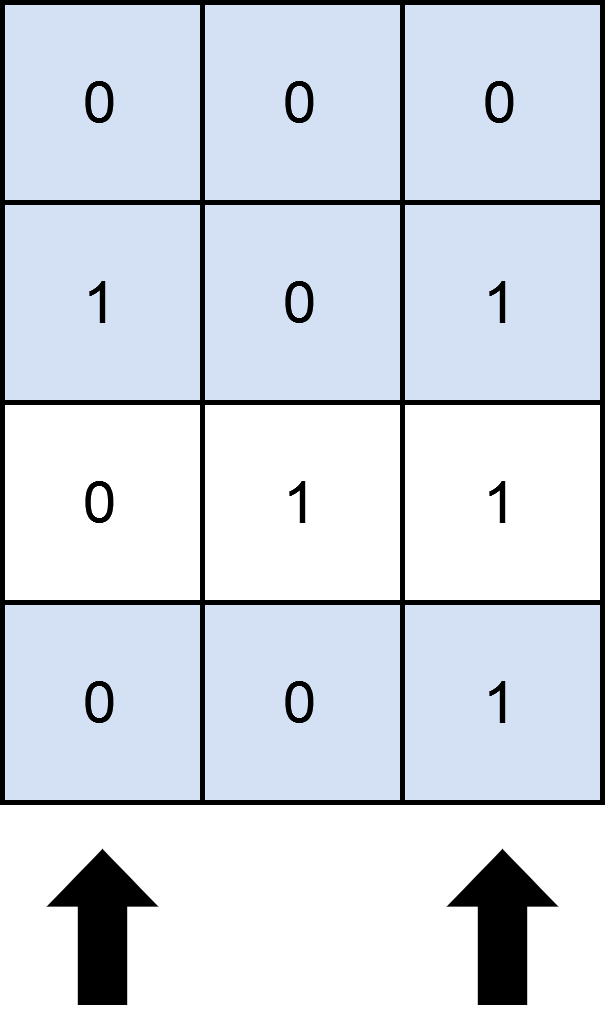Welcome to Subscribe On Youtube
Formatted question description: https://leetcode.ca/all/2397.html
2397. Maximum Rows Covered by Columns
- Difficulty: Medium.
- Related Topics: Array, Backtracking, Bit Manipulation, Matrix, Enumeration.
- Similar Questions: Matchsticks to Square, Partition to K Equal Sum Subsets, Find the Shortest Superstring, Smallest Sufficient Team, Fair Distribution of Cookies.
Problem
You are given a 0-indexed m x n binary matrix matrix and an integer numSelect, which denotes the number of distinct columns you must select from matrix.
Let us consider s = {c1, c2, ...., cnumSelect} as the set of columns selected by you. A row row is covered by s if:
-
For each cell
matrix[row][col](0 <= col <= n - 1) wherematrix[row][col] == 1,colis present insor, -
No cell in
rowhas a value of1.
You need to choose numSelect columns such that the number of rows that are covered is maximized.
Return the **maximum number of rows that can be covered by a set of numSelect columns.**
Example 1:

Input: matrix = [[0,0,0],[1,0,1],[0,1,1],[0,0,1]], numSelect = 2
Output: 3
Explanation: One possible way to cover 3 rows is shown in the diagram above.
We choose s = {0, 2}.
- Row 0 is covered because it has no occurrences of 1.
- Row 1 is covered because the columns with value 1, i.e. 0 and 2 are present in s.
- Row 2 is not covered because matrix[2][1] == 1 but 1 is not present in s.
- Row 3 is covered because matrix[2][2] == 1 and 2 is present in s.
Thus, we can cover three rows.
Note that s = {1, 2} will also cover 3 rows, but it can be shown that no more than three rows can be covered.
Example 2:

Input: matrix = [[1],[0]], numSelect = 1
Output: 2
Explanation: Selecting the only column will result in both rows being covered since the entire matrix is selected.
Therefore, we return 2.
Constraints:
-
m == matrix.length -
n == matrix[i].length -
1 <= m, n <= 12 -
matrix[i][j]is either0or1. -
1 <= numSelect <= n
Solution (Java, C++, Python)
-
class Solution { public int maximumRows(int[][] mat, int cols) { int m=mat.length; int n=mat[0].length; int[] s=new int[n]; return f(0,m,n,cols,mat,s); } public int f(int ind,int m,int n,int cols,int[][] mat,int[] s){ if(cols==0){ int count=0; for(int i=0; i<m; i++){ //supposing that this row is valid boolean selected=true; for(int j=0; j<n; j++){ //if any cell of this row violates the given two conditions, then the row is discarded if(mat[i][j]==1 && s[j]!=1) selected=false; } if(selected) count+=1; } return count; } int ans=-1; for(int i=ind; i<n; i++){ s[i]=1; //do ans=Math.max(ans,f(i+1,m,n,cols-1,mat,s)); s[i]=0; //undo / backtrack } return ans; } } ############ class Solution { private int ans; public int maximumRows(int[][] mat, int cols) { int m = mat.length, n = mat[0].length; int[] arr = new int[m]; for (int i = 0; i < m; ++i) { int x = 0; for (int j = 0; j < n; ++j) { x |= mat[i][j] << j; } arr[i] = x; } int ans = 0; for (int mask = 1; mask <= 1 << n; ++mask) { if (Integer.bitCount(mask) > cols) { continue; } int t = 0; for (int v : arr) { if ((v & mask) == v) { ++t; } } ans = Math.max(ans, t); } return ans; } } -
class Solution: def maximumRows(self, mat: List[List[int]], cols: int) -> int: arr = [] for i, row in enumerate(mat): x = 0 for j, v in enumerate(row): x |= v << j arr.append(x) ans, n = 0, len(mat[0]) for mask in range(1, 1 << n | 1): if mask.bit_count() > cols: continue t = sum((v & mask) == v for v in arr) ans = max(ans, t) return ans ############ # 2397. Maximum Rows Covered by Columns # https://leetcode.com/problems/maximum-rows-covered-by-columns/ class Solution: def maximumRows(self, mat: List[List[int]], k: int) -> int: rows, cols = len(mat), len(mat[0]) res = 0 A = list(range(cols)) for comb in combinations(A, k): filled = 0 for row in mat: ones = row.count(1) curr = 0 for index in comb: if row[index] == 1: curr += 1 if curr == ones: filled += 1 res = max(res, filled) return res -
class Solution { public: int maximumRows(vector<vector<int>>& mat, int cols) { int m = mat.size(), n = mat[0].size(); vector<int> arr(m); for (int i = 0; i < m; ++i) { int x = 0; for (int j = 0; j < n; ++j) x |= mat[i][j] << j; arr[i] = x; } int ans = 0; for (int mask = 1; mask <= 1 << n; ++mask) { if (__builtin_popcount(mask) > cols) continue; int t = 0; for (int v : arr) t += (v & mask) == v; ans = max(ans, t); } return ans; } }; -
func maximumRows(mat [][]int, cols int) int { m, n := len(mat), len(mat[0]) arr := make([]int, m) for i, row := range mat { x := 0 for j, v := range row { x |= v << j } arr[i] = x } ans := 0 for mask := 1; mask <= 1<<n; mask++ { if bits.OnesCount(uint(mask)) != cols { continue } t := 0 for _, v := range arr { if (v & mask) == v { t++ } } ans = max(ans, t) } return ans } func max(a, b int) int { if a > b { return a } return b } -
function maximumRows(matrix: number[][], numSelect: number): number { const [m, n] = [matrix.length, matrix[0].length]; const rows: number[] = Array(m).fill(0); for (let i = 0; i < m; ++i) { for (let j = 0; j < n; ++j) { if (matrix[i][j]) { rows[i] |= 1 << j; } } } let ans = 0; for (let mask = 1; mask < 1 << n; ++mask) { if (bitCount(mask) !== numSelect) { continue; } let t = 0; for (const x of rows) { if ((x & mask) === x) { ++t; } } ans = Math.max(ans, t); } return ans; } function bitCount(i: number): number { i = i - ((i >>> 1) & 0x55555555); i = (i & 0x33333333) + ((i >>> 2) & 0x33333333); i = (i + (i >>> 4)) & 0x0f0f0f0f; i = i + (i >>> 8); i = i + (i >>> 16); return i & 0x3f; }
Explain:
nope.
Complexity:
- Time complexity : O(n).
- Space complexity : O(n).